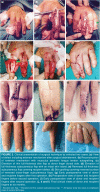Is the cross-finger flap a good option at the extensor zone defect?
- PMID: 32584724
- PMCID: PMC7489178
- DOI: 10.5606/ehc.2020.73030
Is the cross-finger flap a good option at the extensor zone defect?
Abstract
Objectives: This study aims to evaluate the surgical and clinical outcomes of reversed cross-finger subcutaneous flaps applied to patients with dorsal digital defects.
Patients and methods: Between January 2015 and September 2018, 25 (22 males, 3 females; mean age 35.6±11.6 years; range, 19 to 65 years) out of 27 patients under prospective follow-up with finger dorsal digital defect were retrospectively screened and included in the study. The data, obtained by the same two surgeons at six months postoperatively in patients who had undergone reversed cross-finger subcutaneous flaps surgery, concerned cold intolerance, a static two-point separation test, and functional results using range of motion (ROM) and Quick Disabilities of the Arm, Shoulder and Hand (DASH) scoring.
Results: The majority of the patients presented with occupational injury (64%), most commonly to the dominant hand (76%) and the fourth finger (36%) most frequently. Seven patients with extensor tendon defects underwent reconstruction with a palmaris longus autograft. At the six-week postoperative follow-up, all flaps were live, the donor site had no morbidity, and no additional intervention was performed. There was no statistically significant difference in finger joint ROM (p>0.05). Cold intolerance was observed in 14 patients (56%). The mean dynamic two-point distinction was 6.0±0.7 mm and the QuickDASH score was 22.3±5.0.
Conclusion: Due to reasons such as minimal donor site morbidity, satisfactory functional finger outcomes, and easy applicability, reversed cross-finger subcutaneous flap is a good option for reconstruction of defects in the dorsal aspect of the finger with or without extensor mechanism defects.
Conflict of interest statement
Figures


Similar articles
-
Reconstruction of multiple fingertip injuries with reverse flow homodigital flap.Injury. 2014 Oct;45(10):1569-73. doi: 10.1016/j.injury.2014.06.009. Epub 2014 Jun 17. Injury. 2014. PMID: 25037528
-
Long-term outcome of dorsal digital defect reconstruction using reverse-cross-finger flaps.Arch Orthop Trauma Surg. 2025 Sep 11;145(1):445. doi: 10.1007/s00402-025-06038-w. Arch Orthop Trauma Surg. 2025. PMID: 40932569
-
Reconstruction of zone 2 extensor tendon defects with split-thickness turn-down flap: A new technique.J Plast Reconstr Aesthet Surg. 2025 Apr;103:31-35. doi: 10.1016/j.bjps.2025.02.004. Epub 2025 Feb 12. J Plast Reconstr Aesthet Surg. 2025. PMID: 39956046
-
Direct and reversed dorsal digital island flaps: a review of 65 cases.Injury. 2014 Dec;45(12):2013-7. doi: 10.1016/j.injury.2014.08.030. Epub 2014 Aug 20. Injury. 2014. PMID: 25205646 Review.
-
Reconstruction of large dorsal digital defects with arterialized venous flaps: our experience and comprehensive review of literature.Ann Plast Surg. 2013 Jun;70(6):666-71. doi: 10.1097/SAP.0b013e3182433575. Ann Plast Surg. 2013. PMID: 23364671 Review.
Cited by
-
Donor Finger Morbidity in Cross-Finger Flap: A Systematic Review and Meta-Analysis.Indian J Plast Surg. 2023 Feb 7;56(3):201-207. doi: 10.1055/s-0042-1760092. eCollection 2023 Jun. Indian J Plast Surg. 2023. PMID: 37435333 Free PMC article. Review.
-
Are cross finger and thenar flaps effective in the treatment of distal finger amputations with the reposition-flap method?Jt Dis Relat Surg. 2022;33(3):631-638. doi: 10.52312/jdrs.2022.834. Epub 2022 Oct 27. Jt Dis Relat Surg. 2022. PMID: 36345192 Free PMC article.
-
Comparison of Clinical Outcomes of Heterodigital Neurovascular Island Flap, Reverse Homodigital Neurovascular Island Flap, and Cross-Finger Flap Used for Fingertip Reconstruction.Indian J Orthop. 2022 Feb 3;56(5):847-855. doi: 10.1007/s43465-022-00605-8. eCollection 2022 May. Indian J Orthop. 2022. PMID: 35547336 Free PMC article.
References
-
- Pakiam AI. The reversed dermis flap. Br J Plast Surg. 1978;31:131–135. - PubMed
-
- Atasoy E. Reversed cross-finger subcutaneous flap. J Hand Surg Am. 1982;7:481–483. - PubMed
-
- Braga-Silva J, Kuyven CR, Albertoni W, Faloppa F. The adipofascial turn-over flap for coverage of the dorsum of the finger: a modified surgical technique. J Hand Surg Am. 2004;29:1038–1043. - PubMed
-
- Gurbuz K, Uzun E, Ozan F. Covering the dorsal finger defect with reverse cross finger flap. JCAM. 2016;7:262–264.
MeSH terms
LinkOut - more resources
Full Text Sources
Medical

